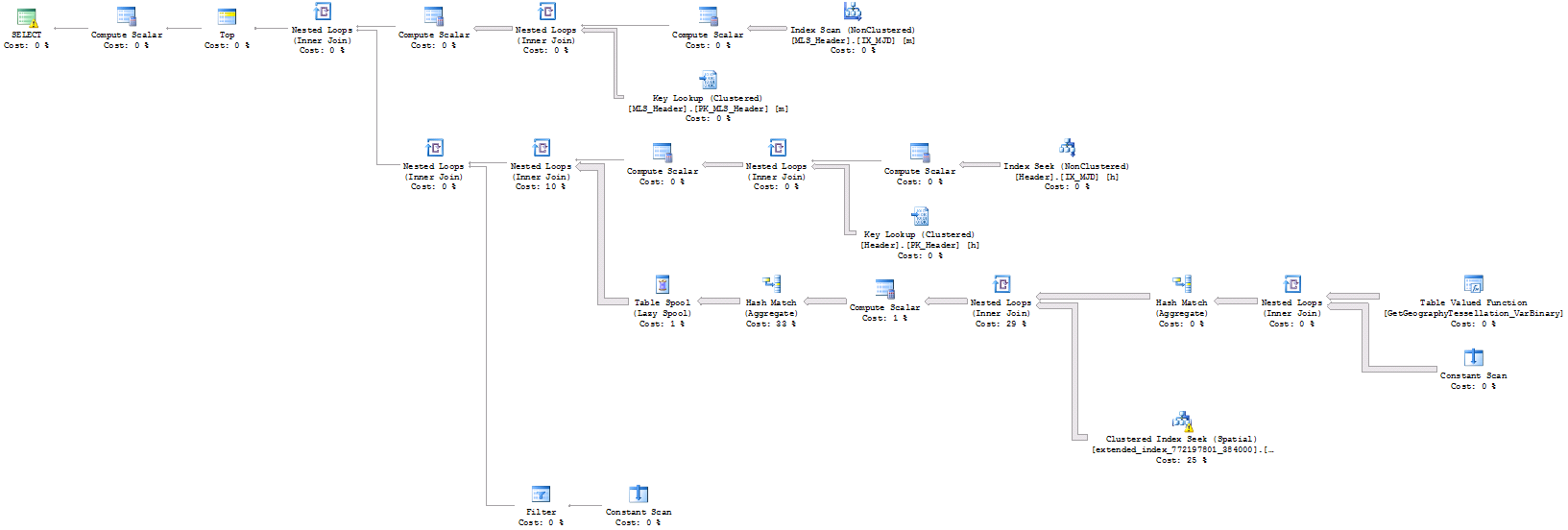I have two sets of earth measurements from satellite data, each with time fields (mjd for mean julian date) and geography positions (GeoPoint, spacial) and I'm looking for coincidences between the two sets such that their times match to a threshold of 3hrs (or .125 days) and their distances to within 200 km of each other.
I have made indexes for both the mjd fields on both tables and spatial tables.
When I just join on the time constraint, the database calculates 100,000 matches in 8 seconds and computes the distances for all 100,000 matches in that time. The query looks like this:
select top 100000 h.Time, m.Time, h.GeoPoint.STDistance(m.GeoPoint)/1000.0
from L2V5.dbo.header h join L2.dbo.MLS_Header m
on h.mjd between m.mjd-.125 and m.mjd+.125
option( table hint ( h, index(ix_MJD) ), table hint( m, index(ix_MJD) ) )
And the executed plan is:

When sorted, 9 of the distances were under 200km, so there are matches. The trouble is, when I add the distance constraint and run this instead,
select top 10 h.Time, m.Time, h.GeoPoint.STDistance(m.GeoPoint)/1000.0
from L2V5.dbo.header h join L2.dbo.MLS_Header m
on h.mjd between m.mjd-.125 and m.mjd+.125
and h.GeoPoint.STDistance(m.GeoPoint)<200000
option( table hint ( h, index(ix_MJD) ), table hint( m, index(ix_MJD) ) )
it goes away for a long time. Obviously, in 8 seconds, it could find 100,000 time matches, 9 of which were under 200km, so the optimizer must be trying something sub-optimal. The plan looks similar to above with a filter on the distances (I'm guessing).

I can force the use of the spatial index with this:
select top 5 h.Time, m.Time, h.GeoPoint.STDistance(m.GeoPoint)/1000.0
from L2V5.dbo.header h join L2.dbo.MLS_Header m
on h.GeoPoint.STDistance(m.GeoPoint)<200000
and h.mjd between m.mjd-.125 and m.mjd+.125
option( table hint ( h, index(ix_MJD), index(ix_GeoPoint) ), table hint( m, index(ix_MJD) ) )

which then takes 3 minutes to find 5 matches.
How do I tell the query optimizer to use the MJD index seek first, and then the spatial index second (or is that what it is doing already) and is there any way I can help it out by telling it how many matches to expect? If it can compute 100,000 matches with distances in 8 seconds that has 9 under 200km, shouldn't the addition of the spatial index make it faster not slower?
Thanks for any other tips or ideas.
EDIT: To answer the question what the plan looks like without the hints, this (and it takes forever):

It maybe also worth mentioning that there are almost 1M records in the one table and 8M in the other
